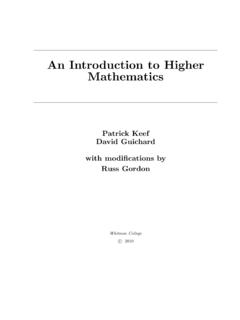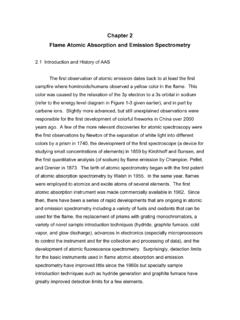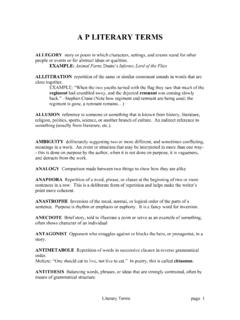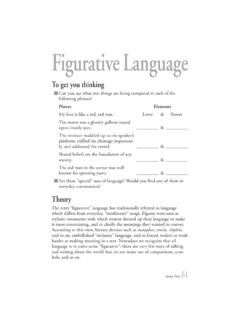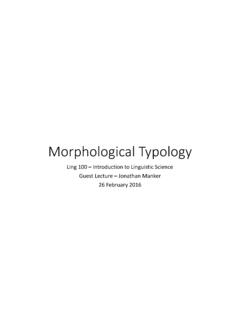Transcription of 'A Brute to the Brutes?' - Whitman People
1 'A Brute to the Brutes?': Descartes' Treatment of Animals JOHN COTTINGHAM I To be able to believe that a dog with a broken paw is not really in pain when it whimpers is a quite extraordinary achievement even for a philo- sopher. Yet according to the standard interpretation, this is just what Descartes did believe. He held, we are informed, the 'monstrous' thesis that 'animals are without feeling or awareness of any kind'.1 The standard view has been reiterated in a recent collection on animal rights, which casts Descartes as the villain of the piece for his alleged view that animals merely behave 'as if they feel pain when they are, say, kicked or stabbed'.2 The basis for this widely accepted interpretation is Descartes' famous doctrine of the 'animal machine' ('bete-machine'); a doctrine that one critic condemns as 'a grim foretaste of a mechanically minded age' which 'brutally violates the old kindly fellowship of living things'.
2 3 But if we look at what Descartes actually says about animals it is by no means clear that he holds the monstrous view which all the com- mentators attribute to him. In fact the traditional rubric 'Descartes' doctrine of the bete-machine' is vague and ambiguous; it needs to be broken down into a number of distinct propositions if we are to sort out what Descartes said, and what he is implicitly committed to, from what he neither said nor implied. Consider, then, the following assertions: (I) Animals are machines (2) Animals are automata (3) Animals do not think (4) Animals have no language (5) Animals have no self-consciousness (6) Animals have no consciousness (7) Animals are totally without feeling 1 N. Kemp Smith, New Studies in the Philosophy of Descartes (London: Macmillan, I952), I36 and I40.
3 2 T. Regan and P. Singer (eds), Animal Rights and Human Obligations (Engle- wood Cliffs, NJ: Prentice Hall, I976), 4. 3 A. Boyce Gibson, The Philosophy of Descartes (London: Methuen, I932), 214. Philosophy 53 I978 55I Discussion Proposition (7) is the 'monstrous thesis' with which Descartes is so often credited. I shall argue that Descartes held theses (i) to (5), but that there is no evidence that he held (7), and even some positive evidence that he regarded (7) as false; however, fuzziness about (6) and its distinction from (5) (together with certain general features of his metaphysics) laid him open to be interpreted as committed to (7). II Thesis (i) is not explicitly asserted by Descartes in this form, but he commits himself to it in so many words in the famous passage on animals in Part V of the Discourse, where he says the body may be regarded 'comme une machine qui, ayant ete faite des mains de Dieu, est incomparable- ment mieux ordonnee.
4 Qu'aucune de celles .. inventees par les hommes'.4 Thesis (i) in fact forms part of Descartes' general scientific 'mechanism', and, roughly translated, means that all animal behaviour is subsumable under physiological laws, which, for Descartes, are ultimately derivable from mathematical principles. Essentially, when Descartes says that 'all the motions of animals originate from the corporeal and mechanical principle',5 he is concerned to promulgate a scientific animal physiology which seeks explanations in terms of efficient rather than final Now from none of all this does it follow that when Descartes calls some- thing a 'mechanism' or 'machine' he is automatically ruling out the pre- sence of sensations or feelings; Boyce Gibson's claim that Descartes 'uses the term [mechanism] explicitly to exclude.
5 Feeling' is not sup- ported by any In fact it is important to notice that the human body is, for Descartes, a machine in exactly the same sense as the animal body: 'God made our body like a machine, and he wanted it to function like a universal instrument, which would always operate in the same way in accordance with its own laws'.8 The phrase 'bete-machine' can thus be rather misleading, since the mechanical physiology Descartes has in mind operates equally in the case of homo sapiens. Of course it is true that in the human, but not the animal, case there is the extra dimension of a 4 AT VI 56; HR I i i6 (references to 'AT' are to volume and page number of Ch. Adam and P. Tannery (eds), Oeuvres de Descartes (Paris: Cerf, 1897-1913); HR stands for E.)
6 S. Haldane and G. T. R. Ross, The Philosophical Works of Descartes (Cambridge: Cambridge University Press, repr. 1969)). 5 Letter to More of 5 February I649: AT V 276; K 243 ('K' stands for A. Kenny, Descartes' Philosophical Letters (Oxford: Clarendon, 1970)). 6 Principles, I, 28 (AT VIII 15; HR I 230). See further AT V 158 and J. G. Cottingham, Descartes' Conversation with Burman (Oxford: Clarendon, 1976), 85f. 7 Nor does Gibson cite any; op. cit., 21I. 8 AT V 163/4; cf. Cottingham, op. cit., 29. 552 Discussion 'soul' (I shall come back to this); but this is a separate point. To deny that X has a soul is a separate claim from the claim that X's movements can be explained by mechanical principles, and is not strictly entailed by it.
7 Proposition (2) is implied frequently by Descartes, and is stated explicitly in a letter to More of 5 February 1649: it seems reasonable since art copies nature, and men can make various automata which move without thought, that nature should produce its own automata much more splendid than the artificial ones. These natural automata are the It is Descartes' use of the term 'automaton' more than any other that has led critics to convict him of holding the monstrous thesis (thus, Kemp Smith speaks of the Cartesian view that animals are 'mere auto- mata .. incapable of experiencing the feelings of well-being or the reverse, hunger or thirst .. ').10 But the inference from 'x is an auto- maton' to 'X is incapable of feeling' is a mistaken one.
8 Webster's dictionary gives the primary meaning of 'automaton' as simply 'a machine that is relatively self-operating'; and neither this nor the subsidiary meaning ('creature who acts in a mechanical fashion') automatically implies the absence of Even today, then, to regard total insensibility as part of the meaning of 'automaton' would seem to be an error; and this seems to have been even more true in the seventeenth century, where 'auto- maton' probably carried no more than its strict Greek meaning of 'self- moving thing'. Thus Leibniz, defending his claim that we possess 'freedom of spontaneity' speaks of the human soul as 'a kind of spiritual automaton', meaning no more than that its action-generating impulses arise solely ab interno, and produce their effects without the intervention of any external What fascinated Descartes' generation about machines ranging from clocks to the elaborately contrived moving statues to be found in some of the royal fountains was simply this.
9 The complex sequences of movements which to primitive (or medieval) man might have appeared as certain proof of some kind of inner motive 'force' or 'spirit', could all be explained quite simply by reference to internal mechanical structure- cogs, levers and the like (Descartes mentions as an example a statue of 9 'deinde quia rationi consentaneum videtur, cum ars sit naturae imitatrix, possintque homines varia fabricare automata, in quibus sine ulla cogitatione est motus, ut natura etiam sua automata, sed artefactis longe praestantiora, nempe bruta omnia, producat' (AT V 277; K 244.) This is a development of material found in Discourse, part V (loc. cit.). 10 Op. cit., I35. 11 Webster's Seventh New Collegiate Dictionary (Springfield, Mass: Merriam, I963).)
10 12 Theodicy, I, 52. 553 Discussion Neptune which would threaten with his trident the approaching onlooker who had unwittingly stepped on a button).13 The point Descartes is concerned to make over and over again about the behaviour of 'natural auto- mata' like dogs and monkeys is that the mere complexity of their move- ments is no more a bar to explanation in terms of inner mechanical struc- ture than is the case with the responses of the trident-brandishing 'Neptune'.14 III So far then, I maintain that Descartes' characterization of animals as 'machines' and 'automata' is of itself quite insufficient to allow us to conclude that he thinks that animals lack feelings. When we get on to the remaining propositions in our list, things are not so simple.


